
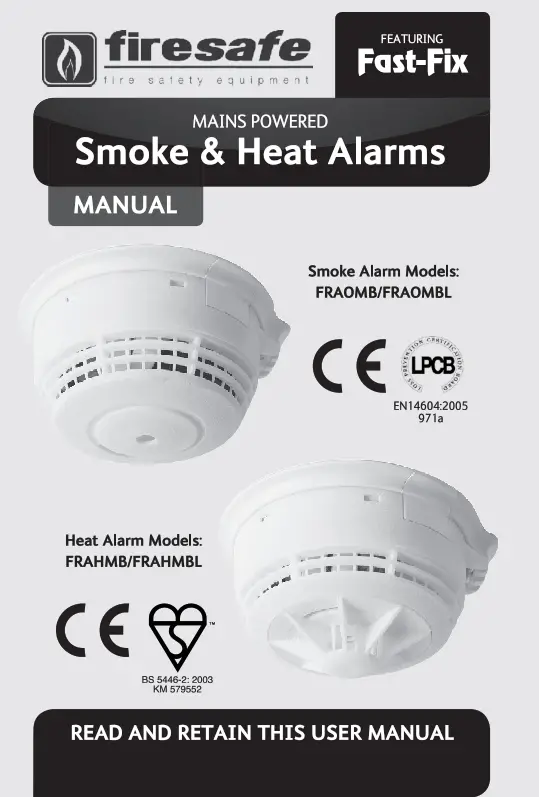
PRODUCT DESCRIPTION
All Firesafe smoke and heat alarms are approved to the most recent and rigorous standards. The photoelectric smoke alarms with their unique X-Profile sensing chambers are approved to EN14604: 2005 and are particularly sensitive to slow smoldering fires typically originating in living rooms, bedrooms, and hallways whilst being highly resistant to nuisance alarms. The Heat alarms are approved to BS5446-2: 2003.
The alarms are guaranteed for 6 years. However, their lives can be significantly reduced by adverse environments, incorrect location, and a failure to regularly clean and maintain them according to the following instructions. Incorrect location and a lack of reasonable care may also cause them to malfunction and will invalidate the warranty. Product Features
- All models are supplied with a backup power source. The FRAOMBL and FRAHMBL has a rechargeable lithium battery. The FRAOMB and FRAHMB have 3 x AAA replaceable alkaline batteries.
- Alarm Silence – Silence your smoke alarm by momentarily pressing the test button. Ideal in non-emergency situations when nuisance alarms may have been created, for example, by steam. The red light flashes every 12 seconds to remind you that the smoke alarm has been silenced and will automatically reset to the quiescent mode in 10 minutes.
- Bespoke software maximizes detection ability and false alarm rejection.
- Power is automatically switched on as the detector is installed onto its mounting plate and automatically switched off when the detector is removed.
- A permanent green LED indicates mains power is connected and switched on.
- Red LED flashes approximately every minute confirming the unit is receiving power and ready to detect fire conditions. (Quiescent Mode)
- Low Battery Warning alarm gives one beep every minute.
- Low Battery Warning Silence -Low battery warnings often start at night. Silence the audible warning for ten hours by pressing the test button, thus avoiding removing the alarm from its mounting plate and turning it off. The batteries on non-rechargeable battery alarms can then be replaced when convenient the following day.
- Extra Large Test Button for ease of use, tests sensitivity, circuitry, power supply and alarm sounder.
- Loud 85 Decibel Piezo Electric alarm automatically resets when hazardous
condition has passed and the chamber is clear. - Easy Installation – Fixing screws and plugs supplied.
- The built-in interconnect facility allows the connection of a combination of up to 15 smoke and heat alarms together so that when one alarm sounds all connected alarms will sound.
- Approved for use in Leisure Accommodation Vehicles
CHOICE AND LOCATION OF ALARMS
Optical Smoke Alarms are best at detecting smoldering fires such as those started in electrical equipment, clothing, and soft furnishings such as seating, bedding, curtains, and carpets, They are, therefore, ideally suited for living rooms, bedrooms, and escape routes in domestic accommodation.
Heat Alarms are most suitable for kitchens, boiler rooms, workshops, and garages where dust, dirt, and moisture contribute to nuisance alarms in smoke alarms.
| NOTE: Heat alarms should NOT be used on walls and in escape routes and should always be interlinked to smoke alarms. |
For minimum protection, install at least one smoke alarm on each level of your home.
They should be installed in hallways, corridors and all escape routes from the building and within 3 meters of all bedroom doors. All alarms should be interconnected. Recommended siting of smoke and heat alarms in:
SINGLE STOREY HOME WITH ONE SLEEPING AREA

SINGLE STOREY HOME WITH TWO SLEEPING AREAS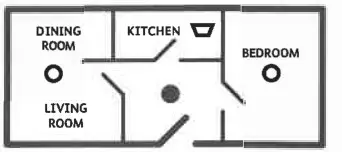
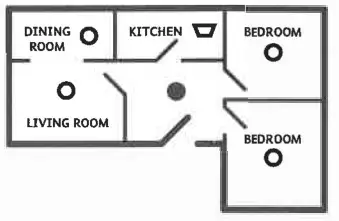
AVOID THE FOLLOWING LOCATIONS
The life of this alarm can be significantly reduced by adverse environments, incorrect location, and a failure to regularly clean and maintain it in accordance with the instructions below. Incorrect location and a lack of reasonable care may also cause it to malfunction and will invalidate the warranty.
- Do not locate near fans or extractors. These can pull smoke and heat away from the alarms.
- Do not install smoke alarms in or near high humidity areas such as showers, bathrooms or kitchens where humidity levels exceed 85% or the room temperature exceeds 40’C or falls below 0’C. These conditions may cause nuisance alarms and damage.
- Do not install in the peak of an “A” frame or sloping ceiling. This may delay smoke and heat reaching them due to the presence of dead air.
- Do not install less than 300mm from walls and light fittings when mounted on the ceiling where heat and dead air may prevent smoke from reaching the alarm.
- Do not install smoke alarms in insect-infested areas.
- Do not install smoke alarms in areas subjected to heavy concentrations of cigarette smoke that will cause nuisance alarms and the alarm to become contaminated.
- Do not install smoke alarms in boiler rooms and garages where fumes and dust may cause nuisance alarms.
- Do not install smoke or heat alarms on poorly insulated walls and ceilings where cold air boundary layers could delay smoke and heat reaching the alarm.
- Do not install near objects that could prevent smoke and heat from reaching the alarm.
- Do not install close to fluorescent light fittings that could trigger nuisance alarms.
- Do not paint the alarm.
The location of the alarms must be in accordance with applicable building regulations, in particular Part B. Further help and guidance can also be found in BS5839 part 6.
FURTHER DETAIL ON ALARM LOCATION
- At least one smoke alarm should be installed in the escape route from all floors of the building.
- The detection element of smoke alarms should be between 25mm and 600mm below the ceiling, or in the case of heat alarms between 25mm and 150mm
- Smoke and heat alarms should be at least 300mm from any wall or light fitting.
- If ceiling mounting is impractical smoke alarms may be installed on walls provided that the area is no longer or wider than 10 meters and the total area does not exceed 50 square meters and that:
a. The detection element is between 150mm and 300mm below the ceiling.
b. The bottom of the detection element is above openings such as vents, doors, and opening windows
c. They are not mounted close to or above heaters or air-conditioning vents. - Where smoke alarms are located in a hallway, corridor, or landing, the alarm should be no further than three meters from any bedroom door to assist audibility behind closed doors.
- For maximum protection no point on the ceiling in any room, hallway or the corridor should be further than 7.5 meters from any smoke alarm.
- To give the earliest warning of a developing fire, smoke alarms should be installed in all the rooms of your home and interlinked. (other than those in section 3, AVOID THE FOLLOWING LOCATIONS, point 2 above).
- Do not install heat alarms in escape routes from the building. Where used in other areas, heat alarms should be no more than 5.3 meters from other heat or smoke alarms.
- Do not install heat alarms in sleeping areas; for example, bedrooms, nurseries, playrooms, or areas where the elderly and disabled may spend long periods of time.
- Do not install heat alarms on walls.
- Do not install heat alarms on ceilings with a slope greater than 60 from the horizontal.
INSTALLATION PROCEDURE
Important Note: Mains powered smoke and heat alarms should be installed by a qualified electrician and in accordance with Part P of the Building Regulations, BS7671 and BS5839 pt 6: 2004 section 15.5, Grade D
systems.
| WARNING: Storing or installing alarms in temperatures below 5C and above 30C, and in low humidity may cause beeping and nuisance alarms when first installed. These will clear after a short time when the alarm has become acclimatized. Extended periods under these conditions will reduce the life of the alarms and invalidate the warranty. Do not expose to dripping or splashing. Disconnect the alarm before dismantling. Interconnect terminals and circuits are not to be accessible and must only ever run to other Interconnect terminals. Do not interconnect to alarms with other brand names or made by other manufacturers. |
The power supply should be from one of two sources:
a. An independent circuit at the dwellings main distribution board with no other electrical equipment connected (other than a dedicated supply failure monitoring device) or:
b. A separately electrically protected and regularly used local lighting circuit. Only suitably approved cabling should be used. The alarms should be wired using a minimum of 1 mm? “3 core and earth” cable (6243Y); with the Brown to Live (L), Grey to neutral (N) and the Black to Interlink([). All alarm circuits should be protected by a 6amp over-current device. The maximum total length of wiring should not exceed 250m. Mini-trunking systems can be used via the removable cover shown in Fig.3 below Installation: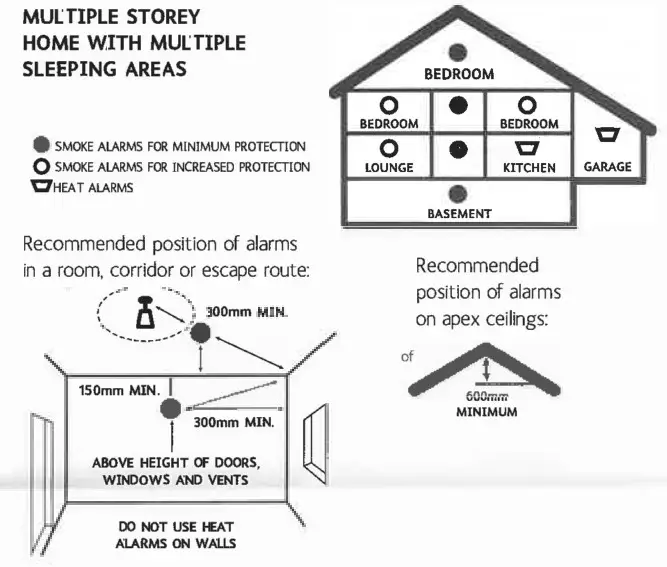
| WARNING: |
- Using the fixings supplied attach the base plate of the alarm to the desired position.
- Connect the supply wires to the connectors – Brown to Live (L), Grey to neutral (N), and the Black to Interlink (I). Be sure to sleeve the bare earth wire and terminate it in the connector shown above.
- BB version only- Fit batteries in accordance with the section “Changing the Batteries” below.
- Close the alarm making sure the 3 retaining clips are fitting securely. When removing the alarms from it’s ase-plate, use a small flat-bladed screwdriver in the slots to push away the clips and lever the alarm away.
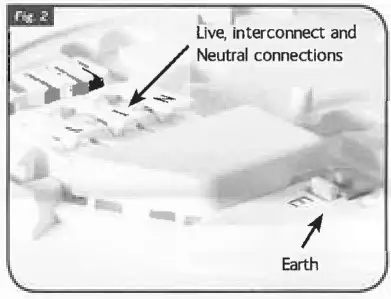
- Test the alarm using the large test button (shown above) without mains power and check it sounds at least 3 times and that the red LED flashes.
- Turn on the mains power supply. (RB versions only – the alarm may beep once every minute for around an hour while the battery charge is topped up).
- Check that the Green LED is on and that the red LED flashes once every minute.
- Test the alarm to check that all other interlinked alarms in the system sound. The LEDs on the other alarms will not flash repeatedly during this operation.
| IMPORTANT NOTE: Use only the test button to test the alarm weekly. Do not test the alarm with either a naked flame or smoke, this will damage and contaminate the alarm causing nuisance alarms in the future. |
USER INFORMATION
Protect your Home Against Fire
Contact your local Fire Brigade for a home safety check, this information is free and will identify potential fire hazards in and around your home.
Make sure all occupants of the home know what a fire alarm sounds like. Prove and practice a fire escape plan and arrange a suitable and safe assembly point.
What to Do If the Alarms Sound
Alarms sounds are as follows:
| Full alarm indicating smoke and fire | Repeating series of 3 beeps every 4 seconds with flashing light | ••• •••• ••••• ••••••• |
| Low Battery | Single beep every minute | • • • • |
| Test button jammed | One beep every 11 seconds | • • • • |
| Fault | Double beep every minute | •• •• •• •• |
If the full alarm sounds. ensure everyone leaves the building as soon as possible.
- Do not run.
- Do not stop to collect belongings.
- If it is safe to do so, close all windows and doors as you escape to prevent the spread of fire.
- Smoke is the main cause of death from fire. If trapped inside the building, over your mouth, conserve breath and crawl to safety.
Do not silence a fire alarm until you know the cause of the alarm and when all occupants are safely outside the building. The red LED on the test button of the alarm that has set the system off will be flashing Red once every second. The lights on the other alarms will be flashing once every minute. The system can only be silenced from this alarm.
CHANGING THE BATTERIES
CAUTION: Danger of explosion if the battery is incorrectly replaced. Replace only with correct batteries.
The alarm will beep once a minute to indicate the batteries need replacing. If this happens at night press the test button to silence the warning for 10 hours and replace the following day. In the event of a low battery warning on the FRAOMBL and FRAHMBL, replace the alarm. The battery is not replaceable. To replace the batteries on the BB version, isolate mains power to the alarm, release the retaining clips, lower the alarm on its hinge and refer to Fig. 4.
Changing the 3 AAA batteries (BB versions only)
Pull out the battery drawer shown here and replace the 3 AAA batteries taking care to insert the new ones in the correct orientation. Re-fit the drawer and re-close the alarm taking care to ensure the alarm is fitted securely and test the alarm.

Alarm Maintenance
A regular program of fire alarm maintenance will help to keep your alarm in good working order.
- Test the alarms weekly making sure that all interconnected alarms in the system sound within 10 seconds.
- Vacuum the alarms every six months and wipe the external surfaces with a damp cloth.
TROUBLESHOOTING
Problems are Indicated In several ways:
- The alarm beeps twice every minute indicating a malfunction.
- The alarm beeps once every minute indicating a low battery. Replace the batteries as above.
- The alarm beeps once every 11 seconds indicating the test button is jammed on. Press the test button to reset.
- The full alarm sounds for no reason. (A repeating series of three beeps with flashing light). Clean the alarm as above.
- The alarm does not sound when pressing the test button.
- The red LED remains steadily on or off. (i.e does not flash approximately once every minute when the unit is not in alarm).
- The green LED is off.
Inspect for obvious damage. Check that the alarm has been installed in accordance with the instructions, that the alarm is connected and the supply turned on. In the case of repeated nuisance alarms. check that it is free from dust, cobwebs, and external contamination from such things as cigarette smoke, drying paint, spray from household aerosols, and steam that may invalidate the warranty. If this does not correct the problem, do NOT attempt to repair it. Other than the replaceable batteries there are no user-serviceable parts. If the alarm is within the warranty period and terms, indicate the nature of the problem and return the unit with proof of purchase to the address at the end of this manual. Units beyond warranty cannot be economically repaired.
PRODUCT WARRANTY
Smoke and heat alarms are sensitive life-saving devices. The life of this alarm can be significantly reduced by adverse environments. incorrect location and a failure to regularly clean and maintain it according to the instructions. correct location and a lack of reasonable care may also cause it to malfunction and will invalidate the warranty.
Firesafe guarantees to you, as the purchaser, that the FRAOMB and FRAHMB alarms with MA battery back-up are guaranteed for 6 years and the FRAOMBL and FRAHMBL with rechargeable lithium batteries are guaranteed for 10 years.
This Guarantee is not assignable. Our liability to you, under this guarantee, is limited to repairing or replacing any part which we find to be defective in material, workmanship or design, free of charge to the customer, upon sending the alarm with proof of date of purchase, postage paid to Firesafe, Sandersons Way, Marton, Blackpool, Lanes, FY4 4NB.
The terms of this guarantee will not apply in the following circumstances: If the alarm has been modified, dismantled, contaminated, damaged, neglected or otherwise abused or altered following the date of purchase, or if it fails to operate due to incorrect siting, installation. maintenance or inadequate or over voltage AC electrical power, or damage caused by failure to abide by the instructions supplied no claim under the guarantee will be entertained.
The liability of Firesafe arising from the sale of this alarm or under the terms of this guarantee shall not, in any case, exceed the cost of replacement of the alarm. In no case, shall Firesafe be liable for consequential loss or damage resulting from the failure of the alarm or the breach of this or any other guarantee? express or implied or for damage caused by failure to abide by the instructions supplied.
This guarantee does not affect your statutory rights.
Firesafe
10 Sandersons Way. Marton.
Blackpool, lanes. FY4 4NB
Technical help-line: 01253 760 800
Email: [email protected]
Website: www.firesafe.co.uk
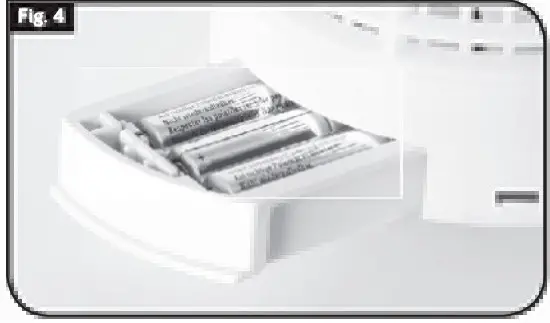 Firesafe Firesafe12 FRA0MB 0832-CPD-1906 FROM 0832-CPD-1907 EN14604:2005 Smoke Alarm Devices For Technical Data see the product handbook |